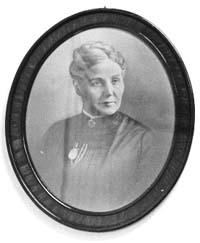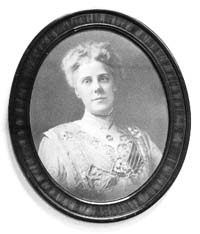
Anna Marie Reeves Jarvis

Anna Jarvis, founder of Mother's Day
Mother's Day Revisited"But After All Was She Not a Masterpiece as a Mother and a Gentlewoman..."By Marie Tyler-McGrawPhotographs by Gary Simmons [Originally published in GOLDENSEAL October-November 1977, Volume 3, Number 4.] In the weeks that followed her mother's death, Anna Jarvis jotted down, on dozens of small pieces of scrap paper, reflections on her mother's life. She intended to put the thoughts together into a biographical memorial to her mother to be distributed among her mother's old friends in Grafton. It seemed to her to be a fitting tribute to the energetic and intelligent mother she deeply mourned. Miss Jarvis never finished the written memorial to her mother. Instead, she founded Mother's Day. |
 Anna Marie Reeves Jarvis |
 Anna Jarvis, founder of Mother's Day |
|
Anna Marie Reeves Jarvis, mother of Anna Jarvis, was a local legend at the time of her death. Without ever stepping beyond the limits of what was considered acceptable and respectable in a 19th century lady, she had organized women, given lectures, worked for peace, and fought disease, all on a local level. She did this so well and so effectively that her courage and goodness became a part of the local folklore, and stories about her were preserved through several generations in Taylor County. Still, without her daughter's strenuous and successful efforts to commemorate her, legend would have faded as the descendants of the people whose lives she touched died or moved from the area. It is because of her daughter's efforts that we can know something about this woman to whom the first Mother's Day was dedicated. Anna Maria Reeves was born in Culpepper County, Virginia, in 1832, the daughter of a Methodist minister. The family moved to Philippi, Virginia, when Anna was about ten. While her father had a Methodist church at Philippi, Anna met and married Granville Jarvis of Grafton. It was 1850 and she was 18 years old. Six years later she had borne six children and four of them were dead. All but one of the dead children had been born healthy. They died from diphtheria, scarlet fever, whooping cough. It was an age in which illness in children was swift and fatal. Anna Maria Jarvis knew there was a relationship between these deaths and the outhouses near the homes, the lack of air and sunshine in many windowless rooms, the milk from sickly cows, the flies buzzing on plates of beef left sitting out in summer kitchens. She organized a Mother's Work group to combat these conditions in the community. Their motto was "Mother's Work — For Better Mothers, Better Homes, Better Children, Better Men and Women." The mothers acted as a direct community action task force, working to have piles of garbage covered, old outhouse areas filled in, eliminating spoiled milk and meat, promoting a campaign for airing and cleaning houses, and caring for the ill. Their efforts seemed to be leading to some real improvement in community health when the Civil War came to Barbour County and changed the function of the Mother's Work group. Barbour County was deeply split between Union and Confederate sympathizers. Mrs. Jarvis saw the paramount need of the community as being reconciliation between neighbors, and this was the goal which she and the Mother's Work group pursued throughout the war. One highly dramatic and myth-like story told about Mrs. Jarvis shows why she became a local legend and was held in such high esteem by her neighbors. The first land battle of the Civil War took place at Philippi and the first soldier killed was killed there. Tempers were short and passions ran high as the young soldier's body was brought into town. A request was made for a prayer to be offered over his body by the assembled townspeople. It was a moment of high tension, as most of the men present were armed and any provocative statement might have set off a partisan battle. Anna Maria Jarvis, a tiny red-haired figure, came forward and prayed over the dead soldier. The crowd became calm and dispersed peacefully. You can read the rest of this article in the Spring 1999 issue of Goldenseal, available in bookstores, libraries or direct from Goldenseal . |